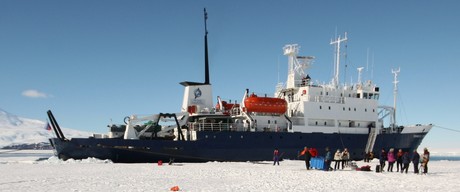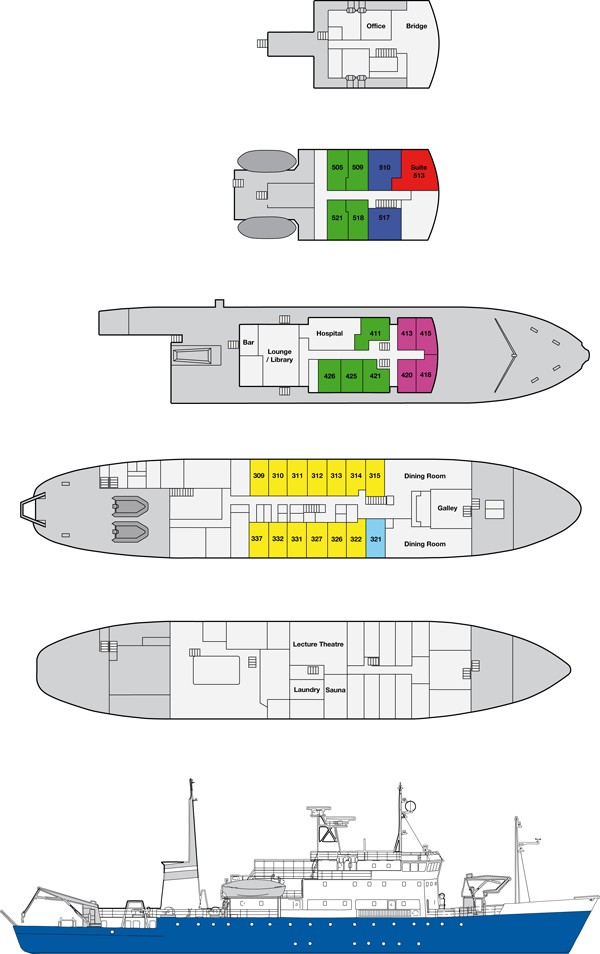
This expedition incorporates many of the key birding areas in the South West Pacific, cruising from New Zealand and following the path of the voyage traditionally know in birding circles as ‘Western Pacific Odyssey or WPO', this itinerary ends in Papua New Guinea. The Western Pacific Odyssey was first offered in 2007 and is now considered one of the ‘must do' expeditions for any birder because of opportunities to see some of the rarest pelagic seabirds in the world plus many island endemics. In addition the cetacean list is outstanding and there will be numerous snorkelling, swimming and relaxing opportunities.
After departing the Port of Tauranga, in New Zealand we sail for the rich waters of the Hauraki Gulf where there are numerous endemic species, including the recently discovered New Zealand Storm-Petrel. From there it's northward to Norfolk Island for a day. Next stop is New Caledonia where we search for the amazing Kagu and other endemics in the Rivière Bleue National Park.
We then spend four exciting days in the Solomon Islands birding on Rennell, Makira, Guadalcanal (Mt Austin) and on Kolombangara, before cruising across the Britain Trench, an area known to be extremely rich in cetaceans. As we sail along the coasts of Bougainville and New Ireland, we will look for two extremely poorly known seabirds, Heinroth's Shearwater and the recently rediscovered Beck's Petrel, both of which we have seen on all previous expeditions in this region. Our final port on this South West Pacific voyage is the township of Kokopo in East New Britain, PNG. Alternatively, stay on board and travel with us throughout Papua New Guinea.
This expedition is accompanied by some of the best pelagic birding guides in the world who have extensive experience of the seabirds of the West Pacific and have visited the islands we will be landing on multiple times before. Birding starts at dawn and finishes at sundown. Our guides are there throughout the day to assist you and the ‘reading of the bird list' each evening is legendary for its detail and discussion. This is one expedition you can't afford to miss.
- Join one of the ‘must do' expeditions for any birder
- Have a good chance of spotting some of the rarest pelagic seabirds in the world plus many endemics
- Approaching New Caledonia try to locate the ‘New Caledonian Storm-Petrel’ which is considered an undescribed species
- Enjoy the hospitality of the people in Anuta Village
- Spot the recently rediscovered Beck’s Petrel
- Enjoy snorkelling and swimming
There are no future departures for this trip at this stage.
Spirit of Enderby/Shokalskiy

The Spirit of Enderby is a fully ice-strengthened expedition vessel, built in 1984 for polar and oceanographic research and is perfect for Expedition Travel.
She carries just 50 passengers and was refurbished in November 2004 to provide comfortable accommodation in twin share cabins approximately half of which have private facilities. All cabins have outside windows or portholes and ample storage space.
On board there is a combined bar/library lounge area and a dedicated lecture room. The cuisine is excellent and is prepared by top NZ and Australian chefs.
The real focus and emphasis of every expedition is getting you ashore as often as possible for as long as possible with maximum safety and comfort. Our Expeditions are accompanied by some of the most experienced naturalists and guides, who have devoted a lifetime to field research in the areas that we visit. The ship is crewed by a very enthusiastic and most experienced Russian Captain and crew.
The name Spirit of Enderby honours the work and the vision of the Enderby Brothers of London. The Enderby Captains were at the forefront of Antarctic exploration for almost 40 years in the early 1800’s. It also celebrates Enderby Island, arguably the greatest Subantarctic Island in the world.
a) our fleet of RIB’s, (rigid inflatable boats) sometimes referred to as zodiacs. These extremely safe and stable craft will land you at some of the most amazing places.
Some departures are on the SHOKALSKIY - the sister ship to the SPIRIT OF ENDERBY
Vessel Type: Expedition
Length: 72 metres
Passenger Capacity: 50
Built / refurbished: 1984 / 2004



